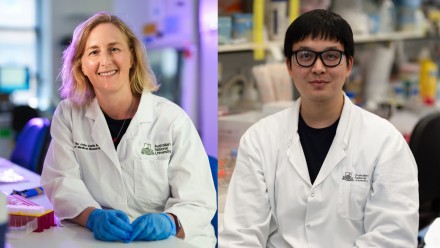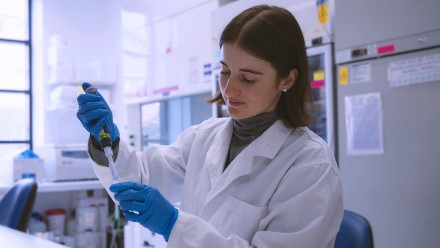About
Our mission
"To build partnerships and capabilities to collaborate and innovate in RNA THERAPEUTICS and RNA DIAGNOSTICS"
The Shine-Dalgarno Centre aspires to drive impactful discoveries and innovations in RNA science to harness the next generation of RNA-based therapeutics and diagnostics, train and foster the future RNA research workforce, as well as to mobilise this workforce and RNA discoveries to areas of strategic health and economic importance to the region and nation.
Shine-Dalgarno Centre for RNA Innovation
Formed during the largest pandemic the world has seen for a century, the Shine-Dalgarno Centre for RNA Innovation brings together experts in RNA biology from across the ACT region to focus their collective efforts and expertise to maximise the power of RNA biology, while simultaneously addressing some of the pressing global health care issues.
The Shine-Dalgarno Centre for RNA Innovation builds on the University’s great legacy in RNA biology. Named in honour of Professor John Shine and Dr Lynn Dalgarno, it challenges our researchers to emulate the impact of the Shine-Dalgarno Sequence, both as a scientific discovery and in transforming biotechnology.
With over 250 years of collective experience in working with RNA, expertise in a wide range of areas, from the fundamental understanding of RNA biology to the role of RNA in complex diseases, and with world-class computational and experimental infrastructure, The Shine-Dalgarno Centre for RNA Innovation aims to deliver innovative research for RNA-based health care.
The Shine-Dalgarno Centre for RNA Innovation works across several disease areas, including, but not limited to:
- Ophthalmology, Neurodegenerative Disease, and Ageing
- Autoimmunity, Infection and Sepsis
- Cancer
- Thrombosis
- Genetic disorders
RNA and the Shine-Dalgarno sequence
Ribonucleic acid (RNA) is central to all biological processes, in particular, the production of proteins as specified by our genes. While proteins are the workhorse of the cell, and DNA is the safe storage medium of genetic information, RNA was initially considered the passive intermediary between these macromolecules.
However, recent studies have uncovered RNA as an active regulator of the expression of genetic information that participates in a number of biological interactions and, importantly, is also the main driver of disease onset and progression. This fundamental change in our perception of RNA functions has revolutionised multiple areas of the life sciences, providing a new arsenal of molecular tools for improving the quality of human health.
The ANU has a long history of studying RNA, reaching back almost fifty years to the discovery of the Shine-Dalgarno sequence by Australian scientists John Shine and Lynn Dalgarno.
Professor John Shine was born on July 3rd, 1946 in Brisbane. He studied at ANU, graduating with a bachelor of science with honours in 1972 before continuing with PhD studies in the Lynn Dalgarno Lab.
Dr Lynn Dalgarno was born on November 12th, 1935 in Melbourne. He joined the ANU Department of Biochemistry as Senior Lecturer in 1968, with an established research focus on RNA viruses and the ribosome’s role in protein synthesis.

John Shine (top-left) and Lynn Dalgarno (top-middle) in 1974.
In the early 1970s, Dalgarno and Shine were working on the nature of initiating signals for protein synthesis in prokaryotic cells. They proposed a ribosomal binding site in bacterial messenger RNA that help initiate protein synthesis by aligning the ribosome with the start codon. Identification of this short sequence, later known as the Shine-Dalgarno Sequence, solved the central question of how the ribosome accurately finds the start of the genetic code in mRNA for faithful protein synthesis.
The discovery of the Shine-Dalgarno Sequence is among the most impactful life science discoveries from Australia of all time. Not only did it transform the fundamental understanding of gene expression and protein synthesis, but it also bolstered the development of molecular biology and the global biotech industry.












